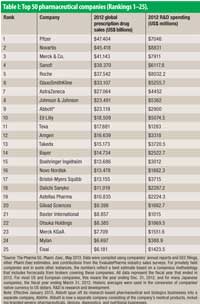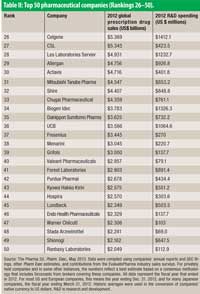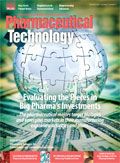Evaluating the Pieces in Big Pharma's Manufacturing Investments
The pharmaceutical majors target biologics and emerging markets in their manufacturing expansion activities and plans.

Günay Mutlu/Getty ImagesThe pharmaceutical majors target biologics and emerging markets in their manufacturing expansion activities and plans.
Restructuring and manufacturing rationalization have been the recent norm for large bio/pharmaceutical companies. Despite such cost-cutting, particularly in small-molecule API and solid-dosage operations, there are some bright spots. A review of leading companies (see Tables I and II) show key trends. Several Big Pharma players are investing in biologic drug-substance, vaccine, and parenteral drug manufacturing and are also making select investments in emerging markets.
Company activity
Pfizer. Pfizer is investing $130 million in two of its Irish manufacturing sites: $100 million at its Grange Castle site in Dublin and $30 million in the Ringaskiddy site in Cork, according to a July 11, 2013 press release from IDA Ireland, Ireland’s industrial development agency. The $100-million investment in Grange Castle is for additional mammalian-cell manufacturing capacity with the addition of a new production line, scheduled to be operational in 2015, when the first process validation batches will be made. In 2011, Pfizer invested $200 million in the Grange Castle site to develop a new suite to expand the manufacturing process for an invasive pneumococcal vaccine, according to IDA.
Bristol-Myers Squibb. Bristol-Myers Squibb is spending approximately $250 million to expand its large-scale biologics manufacturing facility in Devens, Massachusetts. The expansion will introduce biologics development and clinical-trial manufacturing capabilities to the site while adding approximately 350 employees. The Devens site is home to the company’s large-scale bulk biologic manufacturing facility. Construction of the Devens site was completed in 2009. It was the company’s largest single capital investment ($750 million) and provided the company with large-scale bulk biologics production capacity. In May 2012, the company received FDA approval to manufacture its arthritis drug Orencia (abatacept) at the Devens facility. The new $250-million investment will be used to construct two new buildings: one for process development and one for clinical manufacturing. Together, the two buildings will add approximately 200,000 ft2 of laboratory and office space to the Devens site.
Bristol-Myers Squibb also announced plans to locate a North America Capability Center in Tampa, Florida, according to a July 18, 2013 press release from the Office of the Governor of Florida. The 70,000-ft2 facility will open in January 2014 with approximately 250 employees with plans to add more than 325 additional jobs supporting scientific and technical activities at the site by 2017.

Table I: Top 50 pharmaceutical companies (Rankings 1-25)Novartis. In the fourth quarter of 2012, Novartis announced plans to construct a new biotechnology production site in Singapore with an investment valued at more than $500 million. The new facility will focus on drug- substance manufacturing based on cell-culture technology. Construction begins in 2013, and the site is expected to be fully operational in 2016. It will be colocated with the company’s pharmaceutical production site in Tuas, Singapore. In the future, Novartis expects its Singapore site to be a technological competence center for both biotechnology and pharmaceutical manufacturing.
In December 2012, Novartis acquired a 16,000-m2 FDA-approved manufacturing facility in Morris Plains, New Jersey from the biopharmaceutical company Dendreon for $43 million. The facility and certain former Dendreon personnel that were retained will support clinical and commercial production of products from the Novartis-University of Pennsylvania (Penn) collaboration announced in August 2012. Under the Novartis-Penn pact, the parties will research, develop, and commercialize targeted chimeric antigen receptor immunotherapies as well as build on the Penn campus in Philadelphia the Center for Advanced Cellular Therapies, which will be dedicated to developing and manufacturing adoptive T-cell immunotherapies.
On the vaccine side, Novartis is proceeding with a multiyear vaccine-production project. In 2008, it broke ground on a new rabies and tick-borne encephalitis $330-million manufacturing facility in Marburg, Germany. Construction is complete, and the facility is in the process of executing the necessary validation activities with regulatory approvals for products planned for 2013. In 2009, Novartis opened a new cell culture-based influenza vaccine-manufacturing site in Holly Springs, North Carolina. As of Dec. 31, 2012, the total amount spent on the project was $426 million, net of grants reimbursed by the US government. The total investment in this new facility is expected to be at least $900 million, partly supported by grants from the US government and prior investments in influenza cell-culture technologies at the Novartis vaccines site in Marburg, Germany. Novartis is also building a new $475-million vaccine-manufacturing facility in Recife, Brazil. The technical start-up of the facility is planned for approximately 2015.
Novartis is moving forward with other investments. The current phase of the long-term redevelopment of its St. Johann headquarters site in Basel, Switzerland is expected to be finalized in 2015. This project was started in 2001 with the aim of transforming the site from one designed mainly for pharmaceutical production into a center of knowledge with an emphasis on international corporate functions and research activities. Novartis expects that through 2015 it will spend more than $2.3 billion on the project and will transfer production from the site to other facilities in the Basel region.
In the second quarter of 2012, Novartis began construction of a new CHF 500 million ($535 million) solid-dosage manufacturing facility in Stein, Switzerland. The new facility will replace an older facility that will be partially demolished by 2016. Stein is planned to be a technological competence center for sterile and solid dosage drugs. During 2012, Novartis also began a series of projects in which the company expects to invest over $300 million during the next several years in the following three areas: implementation of a serialization product-tracking program across its pharmaceutical operations network, a GMP upgrade for its milling and blending center at Stein, and an upgrade of change-control systems. The company also is continuing a multiyear upgrade of its campus in East Hanover, New Jersey. The company expects that through 2013, it have spent more than $545 million to complete the construction and consolidate operations there.
In emerging markets, Novartis is investing $140 million for a new pharmaceutical plant in St. Petersburg, Russia. Annual production is expected to be 1.5 billion units per year (oral solid dosage forms), of which the majority will be for generic-drug products. Product registration for production at the site is expected to begin in 2014.
In China, Novartis is moving ahead with an expansion of its research facilities. In 2009, Novartis announced it was investing $1 billion to increase its R&D operations in Shanghai. Based on a re-evaluation of the site conducted in 2010, the company expanded its Phase 1 plan to include two buildings to house 800 offices and 400 laboratory work places. As of Dec. 31, 2012, structural work was finished, and the first above-ground buildings began to be built. Novartis also began construction in April 2012 for new laboratory and office space at its research facilities in Cambridge, Massachusetts as part of a multiyear $600-million investment at that site.

Table I: Top 50 pharmaceutical companies (Rankings 26-50)Sanofi. As part of its growth strategy in diabetes, Sanofi’s Frankfurt, Germany site, its principal manufacturing center for diabetes products, is being equipped with a new aseptic processing area that uses isolator technology to improve the aseptic-filling process. This investment will be operational in 2016. Sanofi’s Frankfurt site is one of three dedicated biotechnology hubs that the company is developing in Europe. In 2012, its facility in Vitry-sur-Seine, France, the company’s largest integrated cell-culture facility, produced the first technical batches of aflibercept, the API in the company’s anticancer drug Zaltrap. Its facility in Lyon Gerland, France, is a new world center dedicated to the production of thymoglobulin, a drug to prevent and treat transplant rejection. During 2012, teams at Lyon prepared a dossier for the healthcare authorities as part of the process of transferring production to this site.
In the United States, Sanofi, through its subsidiary Genzyme, has major investments underway, including at its Framingham, Massachusetts biologics site, which was approved by FDA and EMA in 2012 for the manufacture of Fabrazyme (agalsidase beta) to treat Fabry disease. Its site at Allston, Massachusetts moved forward with a major investment program in connection with the implementation of a compliance-remediation workplan approved by FDA in January 2012. Also, in 2012, Sanofi’s Genzyme acquired the Bayer Healthcare facility in Lynnwood, Washington, which specializes in the manufacture of Leukine (sargramostim).
On the vaccine side, Sanofi Pasteur, the company’s vaccine arm, is undergoing a major investment phase, which includes a new dedicated dengue fever vaccine facility in Neuville, France scheduled to produce its first batches in 2014. In response to observations made by FDA during routine inspections conducted in 2012 at Sanofi’s facilities in Toronto and Marcy l’Etoile, France, Sanofi Pasteur initiated a compliance program to address quality issues.
Sanofi is moving forward with other investments in emerging markets. Two new dedicated influenza vaccine-manufacturing facilities are in the start-up phase. Sanofi’s facility in Shenzhen, China is testing its production processes, and its facility in Ocoyoacac, Mexico was approved by Mexican regulatory authorities at the start of 2012 and began production in time for the Mexican influenza vaccination program in September 2012.
The Sanofi diabetes industrial network also is expanding its manufacturing footprint in emerging markets in Russia as well as in China (Beijing), where a new facility that was inaugurated in 2012 began assembly and packaging of SoloSTAR, the prefilled injection system for Lantus (insulin glargine). Also, during 2012, Sanofi’s pharma site in Ankleshwar, Gujarat State, India, handled packaging and quality control through to release for the first commercial batches of AllSTAR, the company’s insulin pen specifically intended for the India market.
Earlier this year, Sanofi began construction for a new $75-million manufacturing in Saigon, Vietnam. The plant, which is scheduled to be operational by the end of 2015, will have an initial capacity of 90 million units per year with a possible extension up to 150 million units. In the Middle East, Sanofi is investing in a new solid-dosage manufacturing facility in Saudi Arabia; products from the facility are expected in 2015. The company is also investing in a new hormonal- products facility in Brasilia, Brazil. The company’s Goa site in India expanded solid dosage production capacity to approximately 2.5 billion pills a year. And in Algeria, Sanofi signed an agreement with the local authorities for a major industrial investment that will lead to the construction of a large industrial complex in the Africa-Middle East region.
Roche. Roche is investing CHF 240 million ($257 million) at its facility in Penzberg, Germany to expand raw-material manufacturing for its Elecsy immunoassays, to be completed by the end of 2014, as well as to increase compounding, filling, and lyophilization capacity, which is planned for 2016. At its sites in Basel and Kaiseraugst, Switzerland, Roche is investing approximately CHF 230 million ($246 million). Three projects were completed in 2012: a new pharmaceutical quality control and assurance building, expansion of cold-chain storage capacity, and a filling line upgrade for Herceptin (trastuzumab) subcutaneous formulation. The company is also expanding capacity for high-potency drugs. Additionally, Roche plans to upgrade the filling line for the cephalosporin antibiotic Rocephin (ceftriaxone) throughout 2013 and 2014. In Shanghai, Roche is investing CHF 260 million ($278 million) for ongoing expansion of its pharmaceutical facilities, including new laboratory, warehouse, office and training facilities, to be completed in 2014.
These moves comes as Roche restructures. In 2012, Roche announced that it is closing its R&D facility in Nutley, New Jersey, which is expected to be completed by the end of 2013. The R&D activities at Nutley are being consolidated at existing sites in Switzerland and Germany and at the planned Translational Clinical Research Center at the Alexandria Center for Life Science in Manhattan in the United States.
GlaxoSmithKline. In 2012, GlaxoSmithKline (GSK) announced it was investing more than £500 million ($767 million) in the United Kingdom across its manufacturing sites, which included selecting Ulverston in Cumbria as the location for the first new GSK manufacturing facility to be built in the UK in almost 40 years. The company also will invest in sites in Montrose and Irvine, Scotland. GSK will locate a new £350-million ($538 million) biopharmaceutical manufacturing facility in Ulverston, Cumbria. Detailed planning and design of the new facility is underway with an anticipated start date for construction of 2014-2015, dependent on portfolio timing and obtaining necessary planning and related consents. Once construction starts, it is likely to take at least six years before the plant is fully operational, according to GSK.
In June 2013, GSK received an offer from South Africa’s Aspen Holdings/Aspen Pharmacare for its facility in Notre-Dame de Bondeville, France and the associated thrombosis brands manufactured at the site. GSK is also proceeding with plans, announced in February 2013, to improve the competitiveness of its European pharmaceutical business and restructure its manufacturing and R&D operations. The company is targeting to realize annual savings of at least £1 billion ($1.5 billion) by 2016.
Eli Lilly. In April 2013, Eli Lilly indicated it plans to invest an additional $180 million in the company’s insulin manufacturing operations in Indianapolis, Indiana. The investment is in addition to the company’s November 2012 announcement for a $140-million expansion of the company’s Indianapolis insulin-manufacturing operations. Eli Lilly is proposing several other ancillary investment projects totaling about $80 million, including a $40-million product-inspection center. The latest $180-million proposed investment would add a second insulin cartridge-filling line and increase its insulin-active-ingredient manufacturing capacity through productivity enhancements. In addition, Eli Lilly is investing EUR 330 million ($436 million) in a new biopharmaceuticals facility at its Kinsale campus in Cork, Ireland, according to a Feb. 27, 2012 IDA Ireland press release.
Merck & Co. Earlier this year, Merck & Co. opened a new $120-million, 75,000-m2 pharmaceutical manufacturing facility in Hangzhou, China. The facility has capacity of up to 16 high speed lines to package pharmaceutical tablets and sterile products. Annual packaging capacity is more than 300 million packages. The facility builds on other recent investment by Merck in China. In 2011, the company established its Asia R&D headquarters in Beijing and committed to invest more than $1.5 billion in R&D in China during the next several years.
AstraZeneca. In June 2013, AstraZeneca announced that Cambridge, United Kingdom will be the location for the company’s new UK-based global R&D center and corporate headquarters. The new £330 million ($507 million) facility in Cambridge will bring together AstraZeneca’s small-molecule and biologics R&D activity. The purpose-built facility, which will be located in the Cambridge Biomedical Campus, is part of the company’s previously announced plan to create strategic global R&D centers in the UK, US, and Sweden by 2016. The company is also proceeding with further restructuring activity, which entails an estimated global headcount reduction of about 5050 over the 2013-2016 period. AstraZeneca also moved forward with two key production facilities during 2012 in China (Taizhou) and Russia (Vorsino) to supply products to both markets locally. These sites are intended to begin phased commercial production in 2014.

Pharmaceutical Tariffs Are Imminent: How Industry is Bracing for Impact
April 16th 2025On April 14, 2025, the Trump Administration launched a national security-driven investigation into pharmaceuticals, a move that will likely result in tariffs being placed on pharmaceutical drugs, ingredients, and other components that are imported from outside of the United States.
Drug Solutions Podcast: A Closer Look at mRNA in Oncology and Vaccines
April 30th 2024In this episode fo the Drug Solutions Podcast, etherna’s vice-president of Technology and Innovation, Stefaan De Koker, discusses the merits and challenges of using mRNA as the foundation for therapeutics in oncology as well as for vaccines.